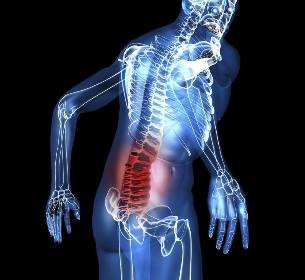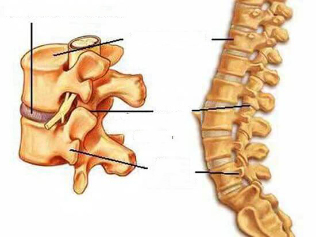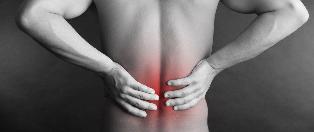
Signs of lumbar osteochondrosis are difficult to detect immediately.Symptoms appear slowly, the diagnosis is made at the stage of exacerbation of the disease.It is important to distinguish between a collapsed spine and other diseases in order to see a doctor immediately. The main signs of spinal osteochondrosis in the lumbar spine:
- Back pain. At first, it manifests itself only when lifting weights, but then becomes fixed. It can no longer be associated with any action. At the time of exacerbation, the pain is unbearable, immediate removal is required.
- Sensory damage to the feet. This occurs as a result of injury to the nerve endings. Initially, there are features of tingling sensation, burning sensation, the appearance of "goose bumps" under the sacrum. If the disease progresses, then in the lower part of the leg, extinction of tendon reflexes and muscle weakness will begin to be observed.
- Excessive sweating.
- Restriction of movement that occurs due to pinching nerves. While turning, bending, changing posture, an attack of pain will occur, similar to an electric shock.
- Cramps in the limbs, skin, pale.
- In severe cases, sexual dysfunction occurs, problems with urination.
Without timely treatment, lumbar osteochondrosis can cause paralysis and deformity.
Deterioration of disease
With a period of relative remission, exacerbations occur. They are characterized by shooting, sharp pain that surrounds and moves to the sciatic nerve. As a result of the development of the disease, numbness reaches the toes. Such attacks interfere with the work of the organs and the small pelvic system. As a result, erectile dysfunction, constipation, and urinary incontinence are observed.
Characteristics of manifestations of lumbar osteochondrosis in women
Pain in the pelvic area with lumbar osteochondrosis adversely affects the female reproductive system.With the development of this disease, the menstrual cycle is disrupted, and its dependence on osteochondrosis attacks can be observed.During pregnancy, osteochondrosis can cause premature birth or miscarriage.
Treatment of osteochondrosis: the main indication
Osteochondrosis of the lumbar spine requires different therapies. Only with an integrated approach can you achieve positive results. The use of drugs will only relieve pain syndrome, will not affect the cause of the disease. To get rid of this disease, you need to use acupuncture, hirudotherapy, therapeutic massage, vacuum action, and even change your normal lifestyle. The treatment plan should be prescribed by a specialist taking into account the degree of osteochondrosis, individual drug tolerance, and the presence of chronic pathology.

Treatment regimens during the acute phase and during remission differ significantly. In the event of deterioration, you must first remove the pressure from the spinal space. For this, the patient must lie down. It is better to use an orthopedic mattress with pillows for the neck and lower back. You need to take muscle relaxants to help relax and relieve cramps. To reduce the consequences of pinching the nerve endings, injections of lidocaine, novocaine are used.
Forgiveness period using the following treatment regimens:
- take vitamin B complex to normalize nerve impulse flow;
- restoration of blood circulation in tissues due to vasodilator drugs;
- undergo physical therapy to reduce the number of exacerbations. Special baths, various types of massages, magnetic therapy, acupuncture are prescribed;
- Physiotherapy exercises, which allow you to form muscle corsets, restore mobility in the lumbar region, and reduce the load on the vertebrae. Exercises are selected by the trainees individually, taking into account body characteristics.
Medication for the treatment of lumbar osteochondrosis
Drugs are divided into forms and methods of exposure:
- anesthetic creams, gels for external use;
- antispasmodic (affects nerves that lead to muscle fibers, has a calming effect, helps reduce cramps, improves blood flow);
- hormonal anti-inflammatory drugs. They are used for severe pain and fatigue. Hormones suppress inflammation, relieve pain, but suppress immunity, remove calcium from bones, and reduce their hormone synthesis.
- chondroprotectors for cartilage tissue recovery. They slow down cartilage destruction, activate intra-articular fluid synthesis, relieve inflammation, stimulate the formation of new cartilage cells;
- non-steroidal anti-inflammatory drugs. The drug reduces pain, relieves inflammation. You have to take it for a long time. They simply eliminate the symptoms, do not affect the pathological cause. Negatively affects the mucous membranes of the gastrointestinal tract, causing gastritis and ulcers.
- B group vitamins
In addition, for osteochondrosis, sedatives are prescribed to regulate the nervous system.
Exercises for lumbar osteochondrosis

Physiotherapy should be done periodically, only in this condition the effect of training will be achieved.Physical activity should be a habit for people with spinal osteochondrosis.Not only a special set of exercises, but also walking has a positive effect on the spine.
There are certain restrictions that must be followed to reduce the risk of injury to the lower back during gymnastics. For example, weight bearing exercises cannot be done. This will cause additional pressure on the spine, which is in a state of disintegration. It is also not recommended to rotate in the lumbar region. This is especially true for patients with protrusion and hernias.
Physiotherapy should not be performed if the patient, other than lumbar osteochondrosis, suffers from injuries, tumors of various origins, and hematomas. It is not recommended for spinal diseases to do active sports.
Diet as a treatment
A well-designed menu will help maintain health and strengthen the body's strength. Diet should include:
- cabbage of various kinds;
- cow liver;
- green beans;
- sea fish;
- beri;
- eggs;
- carrots;
- dried fruit.
Limit salt, pickles, pickles, seasonings, alcoholic beverages, coffee and strong tea.
Possible surgical intervention
Surgery of lumbar osteochondrosis is only prescribed if serious complications occur, for example, an intervertebral hernia.Removal of the most common damaged discs.Surgical intervention is considered a radical action, they are forced to use other methods when other methods do not bring positive results in six months. Modern medicine has high-tech methods for the treatment of microsurgical and endoscopic, less traumatic.



































